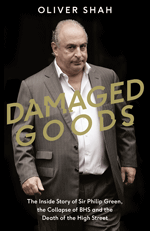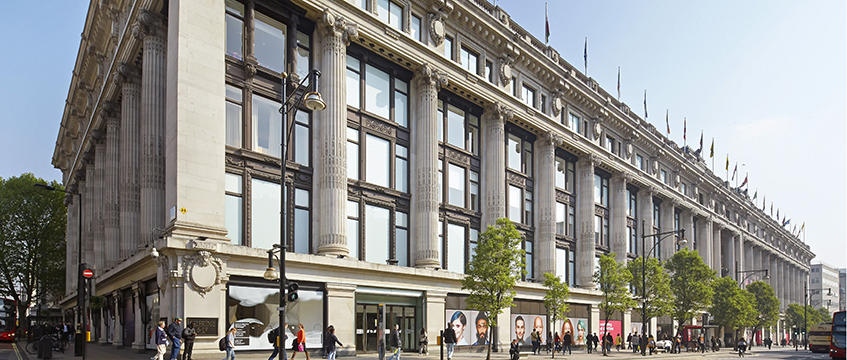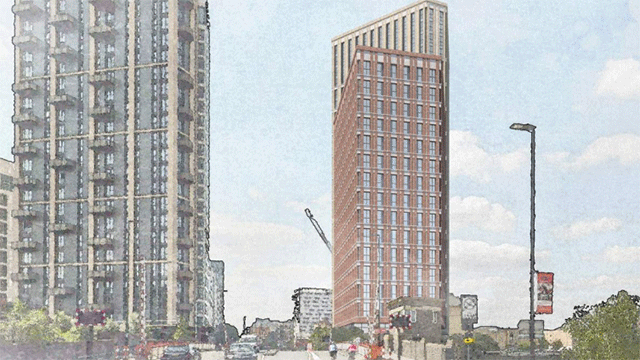One of the biggest stories in retail over the past few years has been that of the collapse of BHS. The department store chain that was once the darling of the high street, presided over by the emperor of retail Sir Philip Green, became the focal point for Sunday Times journalist Oliver Shah. Here, he shares an extract from his account of the collapse of the business and his relationship with the man who ran the empire.
The true secret behind BHS’s incredible surge in profitability was Richard Caring. Between 1979 and 1988, Green’s suave business partner had lived in Hong Kong, where he built up International Clothing Designs, a sourcing operation that supplied clothes to high street retailers such as Marks & Spencer and Next.
Based in a shopping centre in the Kowloon district, overlooking the impressive scenery of Victoria Harbour, ICD was one of the biggest suppliers to BHS and Arcadia. Caring was known to be a particularly clever user of Hong Kong’s quota system. The territory’s garment industry was broken down into different categories.
There was an overall limit on the number of women’s dresses, men’s jackets and other items that could be imported to Britain from Hong Kong every year. Within those categories, each manufacturer had its own allowance. Quota was a tradable commodity, and those who bought and sold at the right times had a pricing edge.
Quota was a key component of the total cost of making a garment – and the lower the price of a garment, the less duty an exporter had to pay. Caring’s nickname, according to traders who knew him then, was “The Quota King”.
After Green acquired BHS, Caring took an office at its Marylebone building. He was the foremost FOP, sitting in on buying meetings and range reviews. He and Green were constantly on the phone to each other.
“They were working eighteen hours a day and they were joined at the hip,” said a friend. “If you were with Caring, Green would be calling him every five minutes.”
Caring was not just a supplier to BHS. Although Green strenuously denied it for years, he was also a shareholder. Green’s family owned 73% of BHS through Global Textiles Investments, a company domiciled in Jersey, which was in turn owned by GH One and GH Two, trusts based in the British Virgin Islands.
Green’s friend Tom Hunter owned 5% through his private equity firm, West Coast Capital. Caring had a secret 22% stake through two BVI companies, Dar Jenna and Lineman Holdings.
Caring’s shareholding was not disclosed to any of BHS’s board members, including Terry Green, the chief executive, or Allan Leighton, the chairman. As a result, none of Green’s lieutenants could understand quite why he was so heavily involved in BHS’s operations.
“Richard was always a bit mysterious,” said one. ‘He’d just say, “I’m partners with Philip,” and that would be it. And I thought, well, I’m not going to ask.”
With Caring’s help, BHS’s operating profit margin shot up from 2.5% in 2001 to more than 10% in 2002, 2003, 2004 and 2005. His hidden role as the second biggest shareholder put him in a different position from other suppliers.
In 2005, an institution considering doing business with Green and Caring commissioned a private investigator’s report into their relationship.
The report said: “PG discusses almost every major commercial decision he makes with RC before proceeding.” It also noted that, in 2004, Caring rearranged his ownership of ICD so that it was held by Global Investments Trust, a company with a strikingly similar name to the Greens’ Global Textiles Investments. Both were registered on Don Street in St Helier, Jersey.
The report floated the idea that Caring was selling clothes to BHS at unrealistically low prices to flatter BHS’s profit margins and help Green beat down other suppliers.
It included several spreadsheets that superficially appeared to back up the claim. One showed figures from a Caring business, Tapestry Design Company, which sold goods to BHS at a margin of 4.8%.
The same company supplied Debenhams at a margin of 12.6% and Tesco at 17.3%. However, the spreadsheet gave only a snapshot of a particular product range over a tiny period of time in 2005.
When I asked Caring about the figures, his lawyers at Carter Ruck replied: “Our client does not recognize the margins to which you refer, and can only assume that these represent certain individual orders or styles . . . In 2005, as in any trading year, goods were sold by Tapestry in hundreds of different styles and at a variety of margins . . .
“Management records for 2005 show that Tapestry’s average margin for goods supplied to BHS was 13%. This is entirely consistent with its average margin to other major retailers for the same period, including Tesco (14%), Next (16%), Debenhams (9%) and Asda (8%).”
In 2016, Caring told Parliament that his stake was kept secret because he was a supplier to some of BHS’s rivals on the high street, and also because other suppliers might have been concerned about his ability to see their product lines and wholesale price points.
With BHS’s profits ostensibly motoring, Green stripped value out of the business on a scale that made his break up of Sears look like childish tinkering.
To investigate the Green family’s transactions with BHS is to pass through a looking glass into a parallel reality where greed is king and almost anything is possible. As the majority shareholder of a private company, Green was free to do whatever he liked within the bounds of the law. It was a freedom he pushed to the limit.
Despite the show he made of improving BHS’s retailing, behind the scenes he seemed to be more focused on extracting huge lumps of cash, which were sent offshore. “I invest my own money,” Green told the Daily Telegraph two years after he bought BHS. “I stand or fall on my own decisions. I take on the risk.”
In fact, Green put no personal equity into BHS at all. He later referred to an equity investment of £20m, but that almost certainly came from his sale of stakes to Richard Caring and Tom Hunter, who paid £10m each.
Green borrowed more than the entire £200m purchase price from Barclays and the London office of WestLB, the German bank that had been supercharged into a racy lending machine by Robin Saunders, the starry young financier from Florida.
Barclays and WestLB made facilities of £264m available to Green – the excess presumably being to cover the deal costs and to provide BHS with working capital.
An adviser who was involved said the banks were prepared to lend so much money because the stock market had seriously undervalued BHS’s property portfolio, which Green reckoned was worth £350m on its own.
Saunders was sold a 0.5% stake in BHS from the Greens’ family shareholding as a reward for her efforts.
The financing was expensive. Between 2000 and 2005, BHS paid £69m of interest to cover the cost of Green’s acquisition, including £9.5m to his wife, Tina, who subscribed to £29m of BHS bonds through a Jersey-based company called Tacomer (BHS repaid Tacomer’s bonds in 2005).
Green had to race to pay off the first slice of bank lending within five days.
Despite its trading problems, BHS owned some of the best real estate on the high street. Green’s masterstroke was to transfer ownership of the nine stores in the best locations – plus BHS’s Marylebone headquarters – to his family.
Because he planned to own the properties through an offshore company, the arrangement would allow him to collect rent directly from BHS as a tax-free income stream.
Green set up a Jersey-based company called Carmen, which would buy the BHS properties. Tina owned 75% of Carmen through a Jersey-based trust called Nautilus. Hunter owned the other 25%.
Green was helped by Malcolm Dalgleish, the trusted property adviser who had worked with him since the Sears days. Dalgleish made sure that Carmen’s properties commanded the highest possible rents.
As with the main BHS takeover, Green put no money into this deal. Carmen borrowed £106m from a syndicate led by Bayerische Hypo- und Vereinsbank, an obscure German bank. (The German loan was later refinanced by HBOS.) Green used the German cash to pay BHS £106m for the properties.
BHS then put the proceeds of the property sale towards a dividend of £167m that it paid to Green, Caring, Hunter and Saunders in 2002. In other words, Green used bank debt to buy the 10 best-located properties from BHS and immediately refunded himself a figure in excess of the purchase price.
One of Green’s advisers pointed out the sale-and-leaseback device could have been carried out by Storehouse, but that the public company “failed to do what is fundamentally a simple transaction that Philip saw the opportunity to do”.
Assets and cash gushed from BHS and its lenders into the new owners’ bank accounts. The dividends pushed BHS into a loss of £51.6m for 2002. As Richard Caring worked his magic and BHS’s profits ballooned, Green took further paydays.
BHS paid £57m of dividends in 2003 and £200m in 2004 – the latter funded by new borrowings from Barclays Capital, based on its improving performance.
The total came to £423m. With their 73%, Green’s family received payouts of £308m. Caring took £93m, and Hunter and Saunders shared the remaining £22m.
Green’s family and Hunter also received £136m tax-free rental income via Carmen, having cranked up the rent BHS paid for the 10 properties by 20%.
The £9.5m Tacomer bond interest, £308m of dividends and £102m share of the Carmen rent took the Green family’s haul from BHS to almost £420m.
Considering he had risked no money of his own, it wasn’t bad – and there was a lot more to come.
Extracted from Damaged Goods by Oliver Shah, published by Portfolio Penguin at £18.99.
Copyright © Oliver Shah 2018, penguin.co.uk











